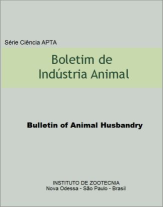Genetic diversity in Stylosanthes capitata ACCESS
DOI:
https://doi.org/10.17523/bia.v72n4p284Keywords:
morphology, dissimilarity, Mahalanobis distance, forage, legume, canonical variable.Abstract
The objective of this study was to evaluate the genetic diversity and the relative importance of morphological traits for the study of genetic diversity among Stylosanthes capitata genotypes. Ten open-pollinated families (297-2, 49-5, 1064-4, 49-4, 1095-5, 141-6, 1064-6, 297-6, 625-3, and 111-3), previously selected by the Embrapa Gado de Corte improvement program, and the Campo Grande cultivar as control were evaluated. A completely randomized design consisting of four repetitions was used. The following morphological traits were studied: type of growth, length, width and length-to-width ratio of the central and lateral leaflets, plant height, stem length, and number of secondary ramifications. Mahalanobis generalized distance was calculated using the phenotypic means for each trait and the matrix of residual variances and covariances. Once the dissimilarity matrix was obtained, the families and Campo Grande cultivar were grouped using Ward€™s method. Canonical variables were also analyzed using the phenotypic mean of the traits studied and the matrix of residual variances and covariances. Cluster analysis by Ward€™s method permitted to divide the 11 genotypes into five groups. Canonical analysis was efficient since it permitted to summarize the total variation observed in the nine morphological traits into only three canonical variables, which accounted for 81.65% of the total variation in the data. The importance of the traits for clustering was also analyzed. Central leaflet width, length-to-width ratio of the central and lateral leaflets, lateral leaflet width and secondary ramifications were the most important traits for the evaluation of genetic diversity among Stylosanthes capitata genotypes.Downloads
Downloads
Published
Issue
Section
License
Os autores não serão remunerados pela publicação de trabalhos, pois devem abrir mão de seus direitos autorais em favor deste periódico. Por outro lado, os autores ficam autorizados a publicar seus artigos, simultaneamente, em repositórios da instituição de sua origem, desde que citada a fonte da publicação original seja Boletim de Indústria Animal. A revista se reserva o direito de efetuar, nos originais, alterações de ordem normativa, ortográfica e gramatical, com vistas a manter o padrão culto da língua e a credibilidade do veículo. Respeitará, no entanto, o estilo de escrever dos autores. Alterações, correções ou sugestões de ordem conceitual serão encaminhadas aos autores, quando necessário. Nesses casos, os artigos, depois de adequados, deverão ser submetidos a nova apreciação. As opiniões emitidas pelos autores dos artigos são de sua exclusiva responsabilidade. Todo o conteúdo deste periódico, exceto onde está identificado, está licenciado sob a Licença Creative Commons Attribution (CC-BY-NC). A condição BY implica que os licenciados podem copiar, distribuir, exibir e executar a obra e fazer trabalhos derivados com base em que só se dão o autor ou licenciante os créditos na forma especificada por estes. A cláusula NC significa que os licenciados podem copiar, distribuir, exibir e executar a obra e fazer trabalhos derivados com base apenas para fins não comerciais.













